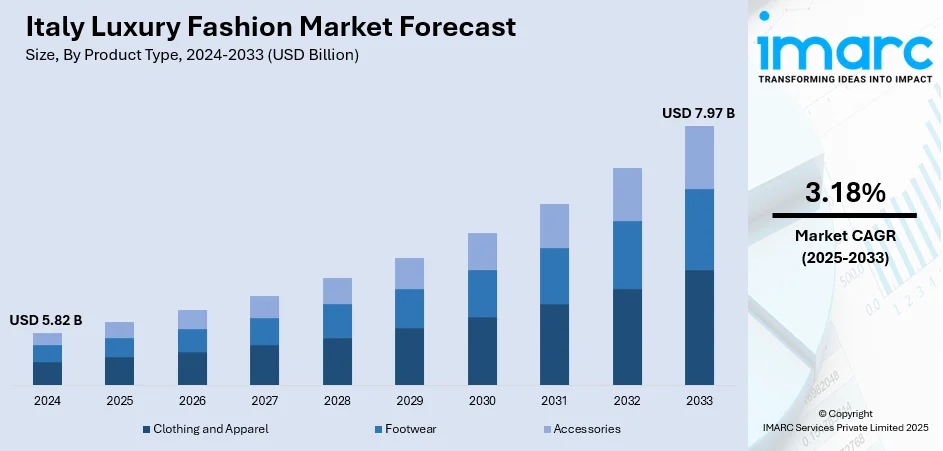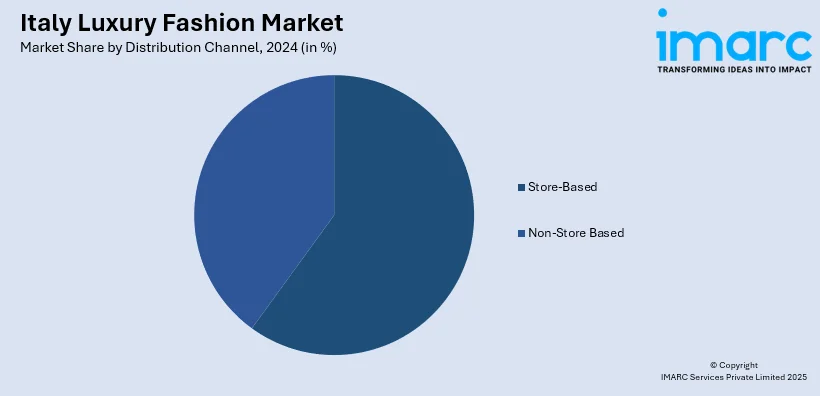
Italy Luxury Fashion Market Size, Share, Trends and Forecast by Product Type, Distribution Channel, End User, and Region, 2025-2033
Italy Luxury Fashion Market Overview:
The Italy luxury fashion market size reached USD 5.82 Billion in 2024. The market is projected to reach USD 7.97 Billion by 2033, exhibiting a growth rate (CAGR) of 3.18% during 2025-2033. The market is fueled by rising disposable incomes and an expanding demand for luxurious, high-end products among upscale consumers. Besides that, the strong history in fashion by the country, underpinned by internationally known brands and high-end fashion events attracts both local and international buyers. Further, the growth of e-commerce platforms and digital media boosts the visibility and accessibility of brands, which is one of the major drivers augmenting the Italy luxury fashion market share.
|
Report Attribute
|
Key Statistics
|
|---|---|
|
Base Year
|
2024 |
|
Forecast Years
|
2025-2033
|
|
Historical Years
|
2019-2024
|
| Market Size in 2024 | USD 5.82 Billion |
| Market Forecast in 2033 | USD 7.97 Billion |
| Market Growth Rate 2025-2033 | 3.18% |
Italy Luxury Fashion Market Trends:
Digital Transformation and E-commerce Expansion
The increasing digitalization is positively impacting the market development. High-end brands are extending their reach on e-commerce platforms, investing in digital solutions to increase customer interactions. Online shopping has picked up a huge pace in Italy, with about 57% of Italians now making at least half of their purchase online. According to industry reports, about 89% of consumers believe in the quality and reliability of items purchased on digital platforms. Additionally, 92% of the consumers think that purchasing directly from manufacturers, on platforms like Temu, saves them money without compromising on product quality. As a response, Italian fashion luxury brands, traditionally centered around physical outlets and face-to-face experiences, are now leveraging online platforms to connect with the global market, particularly for young consumers who value convenience and accessibility. In addition, the transition is defined by embracing innovative technologies like augmented reality (AR) and virtual try-ons, which provide customers with an engaging shopping experience. This digital evolution enables brands to be exclusive yet extend the accessibility of luxury fashion globally. Besides, social media also acts as a crucial marketing platform for luxury goods. Instagram, more specifically, is one of the most important tools utilized in promoting brands, allowing direct contact with clients and serving as a platform for the display of exclusive collections. Apart from this, the increasing need for digital purchases and individualized digital experiences ensures that luxury brands continue to innovate in their digital strategies.

To get more information on this market, Request Sample
Sustainability and Ethical Consumerism
Sustainability has emerged as a key driver of the Italy luxury fashion market growth. As environmental awareness increases among consumers, luxury brands are shifting their focus toward sustainable practices across their production lines. This transition encompasses the use of sustainable materials, waste minimization, and transparency in production and sourcing. According to an industry report, Italian consumers are highly willing to pay considerably more for bio-based products that are certified, with prices ranging between 64% and 128% above traditional prices. This movement demonstrates an increasing demand for sustainable fashion and highlights the increasing impact of environmental factors on purchasing behavior. Italian high-fashion brands are catering to this demand by embracing the use of green methods, from organic cotton to recycled material, as well as encouraging the use of cruelty-free leather and other sustainably sourced materials. Further, the surge in ethical consumerism is also resulting in a change in consumer preferences, where consumers are opting for brands with a social and environmental conscience. Furthermore, the importance of sustainability in high-end fashion has given rise to eco-friendly collections and partnerships, enabling brands to access a growing base of consumers interested not only in exclusivity but also in environmental responsibility. In response, luxury brands are now more open about their supply chain and the environmental impact of their products.
Italy Luxury Fashion Market Segmentation:
IMARC Group provides an analysis of the key trends in each segment of the market, along with forecasts at the country and regional levels for 2025-2033. Our report has categorized the market based on product type, distribution channel, and end user.
Product Type Insights:
- Clothing and Apparel
- Jackets and Coats
- Skirts
- Shirts and T-Shirts
- Dresses
- Trousers and Shorts
- Denim
- Underwear and Lingerie
- Others
- Footwear
- Accessories
- Gems and Jewellery
- Belts
- Bags
- Watches
The report has provided a detailed breakup and analysis of the market based on the product type. This includes clothing and apparel (jackets and coats, skirts, shirts and T-shirts, dresses, trousers and shorts, denim, underwear and lingerie, and others), footwear, and accessories (gems and jewellery, belts, bags, and watches).
Distribution Channel Insights:

- Store-Based
- Non-Store Based
A detailed breakup and analysis of the market based on the distribution channel have also been provided in the report. This includes store-based and non-store based.
End User Insights:
- Men
- Women
- Unisex
The report has provided a detailed breakup and analysis of the market based on the end user. This includes men, women, and unisex.
Regional Insights:
- Northwest
- Northeast
- Central
- South
- Others
The report has also provided a comprehensive analysis of all the major regional markets, which include Northwest, Northeast, Central, South, and others.
Competitive Landscape:
The market research report has also provided a comprehensive analysis of the competitive landscape. Competitive analysis such as market structure, key player positioning, top winning strategies, competitive dashboard, and company evaluation quadrant has been covered in the report. Also, detailed profiles of all major companies have been provided.
Italy Luxury Fashion Market News:
- July 2025: Canadian athletic apparel brand lululemon inaugurated its first-ever store in Italy, in Milan’s prestigious shopping district. The two-level, 5,700 sq ft flagship showcases the full range of men’s and women’s collections, and features a sculptural “Glide” façade, a custom 3D‑printed installation inspired by the Define Jacket pattern that blends Italian artisanal tradition with contemporary design. This opening marks a pivotal milestone in lululemon’s broader “Power of Three ×2” expansion strategy, which aims to quadruple its international revenue from 2021 levels by the end of 2026.
Italy Luxury Fashion Market Report Coverage:
| Report Features | Details |
|---|---|
| Base Year of the Analysis | 2024 |
| Historical Period | 2019-2024 |
| Forecast Period | 2025-2033 |
| Units | Billion USD |
| Scope of the Report |
Exploration of Historical Trends and Market Outlook, Industry Catalysts and Challenges, Segment-Wise Historical and Future Market Assessment:
|
| Product Types Covered |
|
| Distribution Channels Covered | Store-Based, Non-Store Based |
| End Users Covered | Men, Women, Unisex |
| Regions Covered | Northwest, Northeast, Central, South, Others |
| Customization Scope | 10% Free Customization |
| Post-Sale Analyst Support | 10-12 Weeks |
| Delivery Format | PDF and Excel through Email (We can also provide the editable version of the report in PPT/Word format on special request) |
Key Questions Answered in This Report:
- How has the Italy luxury fashion market performed so far and how will it perform in the coming years?
- What is the breakup of the Italy luxury fashion market on the basis of product type?
- What is the breakup of the Italy luxury fashion market on the basis of distribution channel?
- What is the breakup of the Italy luxury fashion market on the basis of end user?
- What is the breakup of the Italy luxury fashion market on the basis of region?
- What are the various stages in the value chain of the Italy luxury fashion market?
- What are the key driving factors and challenges in the Italy luxury fashion market?
- What is the structure of the Italy luxury fashion market and who are the key players?
- What is the degree of competition in the Italy luxury fashion market?
Key Benefits for Stakeholders:
- IMARC’s industry report offers a comprehensive quantitative analysis of various market segments, historical and current market trends, market forecasts, and dynamics of the Italy luxury fashion market from 2019-2033.
- The research report provides the latest information on the market drivers, challenges, and opportunities in the Italy luxury fashion market.
- Porter's five forces analysis assist stakeholders in assessing the impact of new entrants, competitive rivalry, supplier power, buyer power, and the threat of substitution. It helps stakeholders to analyze the level of competition within the Italy luxury fashion industry and its attractiveness.
- Competitive landscape allows stakeholders to understand their competitive environment and provides an insight into the current positions of key players in the market.
Need more help?
- Speak to our experienced analysts for insights on the current market scenarios.
- Include additional segments and countries to customize the report as per your requirement.
- Gain an unparalleled competitive advantage in your domain by understanding how to utilize the report and positively impacting your operations and revenue.
- For further assistance, please connect with our analysts.
 Request Customization
Request Customization
 Speak to an Analyst
Speak to an Analyst
 Request Brochure
Request Brochure
 Inquire Before Buying
Inquire Before Buying




.webp)




.webp)












